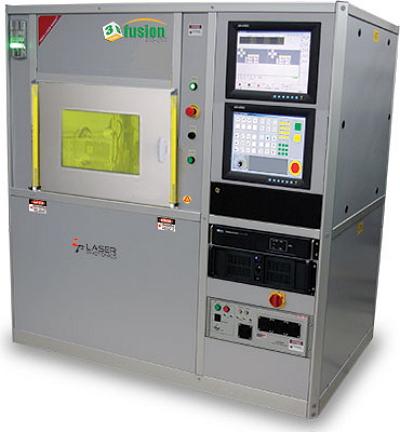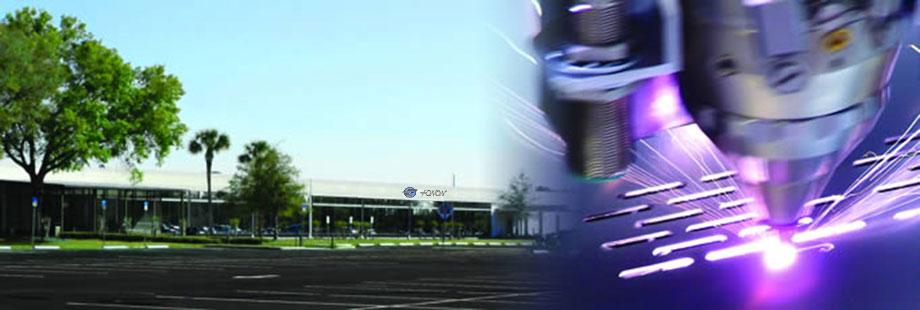 A fiber laser is a system that uses an optical fiber doped with rare earth elements such as dysprosium, praseodymium, erbium, ytterbium, neodymium, dysprosium, praseodymium, and thulium.
A fiber laser is a system that uses an optical fiber doped with rare earth elements such as dysprosium, praseodymium, erbium, ytterbium, neodymium, dysprosium, praseodymium, and thulium.
Fonon Corporation says their additive manufacturing fiber laser devices feature improved laser management practices capable of fine-tuning product density and reducing build rate cycle times.
Fonon’s Direct Metal Laser Sintering (DMLS) process prevents fluctuations in laser power during operation, which adversely impact quality control management of density, while their high-frequency laser provides, according to the company “a flat, uniform power density ensuring that the metal powder materials used are melted with no variation during the build cycle.”
 Fonon says that using higher wattage lasers typically means a larger beam spot size at the point of powder interaction, which is not ideal in terms of production control for specification tolerances. While it may mean faster processing speeds, Fonon says their 1KW laser is 95% scalable, and that means users gain the benefit of faster processing speeds and the ability for end-users to control the beam spot size at crucial locations within the build area.
Fonon says that using higher wattage lasers typically means a larger beam spot size at the point of powder interaction, which is not ideal in terms of production control for specification tolerances. While it may mean faster processing speeds, Fonon says their 1KW laser is 95% scalable, and that means users gain the benefit of faster processing speeds and the ability for end-users to control the beam spot size at crucial locations within the build area.
Fonon develops each of their 3D DMLS printing systems specifically for the requirements of each individual customer. Their design allows customers to optimize their consumption of what are generally very expensive nano powders.
Fonon devices feature build plate sizes – using the company’s proprietary Scalable Reach Technology – in ranges from 500 x 500 mm to 4000 x 2000 mm. Fonon says their building block technology for 3D metal printing systems can extend to end-user applications which include manufacturing automotive engines or turbine blades and tooling large-volume production systems that are currently limited to typical build plate sizes of 250 x 250 mm.
They say their process also reduces inert gas flow rates. They define the optimal laser power requirements in relation to specific applications.
“We solely develop all 3D Direct Metal printing systems for specific customer requirements, targeting maximum performance for 3D printing of specialized designs, parts and applications,” Fonon says. “Our designs allow customers to optimize expensive nano powder consumption, reduce inert gas flow rate, optimize throughput verses surface roughness, minimize powder fill up volume in the process chamber, define optimal laser power requirements, optimize system costs in relation to application (design for the warhead 3D metal sintering system is different from the design of medical contact pads mold forms prototyping, even if they have the similar horizontal cut dimensions).”
 Fonon systems are used in the automotive, aerospace, industrial, defense, electronic, semiconductor, flat panel display, and medical industries. They offer standard 3D material processing systems and 3D laser-based transforming systems – all designed according to the unique application requirements of customers.
Fonon systems are used in the automotive, aerospace, industrial, defense, electronic, semiconductor, flat panel display, and medical industries. They offer standard 3D material processing systems and 3D laser-based transforming systems – all designed according to the unique application requirements of customers.
The company’s 3D Metal Fusion Technology is complemented by 3D engraving capabilities via their Zero Width Laser Cutting Technology.
Have you ever seen one of the industrial-grade Fonon Corporation DMLS printers at work? Let us know in the Fonon DMLS AM Systems forum thread on 3DPB.com.
Subscribe to Our Email Newsletter
Stay up-to-date on all the latest news from the 3D printing industry and receive information and offers from third party vendors.
You May Also Like
Precision at the Microscale: UK Researchers Advance Medical Devices with BMF’s 3D Printing Tech
University of Nottingham researchers are using Boston Micro Fabrication‘s (BMF) 3D printing technology to develop medical devices that improve compatibility with human tissue. Funded by a UK grant, this project...
3D Printing Webinar and Event Roundup: April 21, 2024
It’s another busy week of webinars and events, starting with Hannover Messe in Germany and continuing with Metalcasting Congress, Chinaplas, TechBlick’s Innovation Festival, and more. Stratasys continues its advanced training...
3D Printing Webinar and Event Roundup: March 17, 2024
It’s another busy week of webinars and events, including SALMED 2024 and AM Forum in Berlin. Stratasys continues its in-person training and is offering two webinars, ASTM is holding a...
3D Printed Micro Antenna is 15% Smaller and 6X Lighter
Horizon Microtechnologies has achieved success in creating a high-frequency D-Band horn antenna through micro 3D printing. However, this achievement did not rely solely on 3D printing; it involved a combination...






























